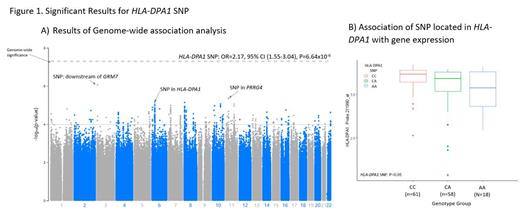Acute myeloid leukemia (AML) patients' clinical outcomes are associated with genetic abnormalities present in leukemic blasts. However, the significance of common genetic variants with regards to variation in AML treatment outcome remains elusive. To that end, we conducted a genome wide association study (GWAS) on 400 pediatric patients diagnosed with de novo AML to identify single nucleotide polymorphisms (SNPs) that may be associated with minimal residual disease (MRD) after the initial induction chemotherapy. Integrating our top SNPs from GWAS results with matched AML-derived transcriptomic data, we performed an expression quantitative trait loci (eQTL) analysis to determine which variants may affect the expression of one or more genes.
Array-based whole-genome genotyping with imputation was used to investigate SNPs for association with MRD outcome in 2 pediatric AML cohorts: the multi-site AML02 [NCT00136084, n=167] and AML08 [NCT00703820, n=233] trials. Genotype imputation was performed via TOPMED Imputation Server and yielded 6,741,200 SNPs. MRD positivity was defined as 1 or more leukemic cells per 1000 mononuclear bone-marrow cells. Association analysis with adjustment for ancestry was conducted using logistic regression to model MRD positivity with SNP as a predictor. Genome-wide significance level was set at Bonferroni-corrected P<5x10 -8 and a suggestive significance level of P<1x10 -4. For gene expression profiling, the mRNA expression levels for 137 patients were obtained at diagnosis using GeneChip Human Genome U133A array from patients in the AML02 cohort. For eQTL analysis, we evaluated the association of gene expression using a 500kb window surrounding the top SNPs identified in the GWAS using a linear regression model.
A total of 92 SNPs reached the suggestive significance level but none passed the genome-wide threshold. Of the 92 SNPs, 10 SNPs were mapped to the Major Histocompatibility Complex, Class II, DP Alpha 1 gene (HLA-DPA1), with 8 of the 10 SNPs associated with an increased risk of MRD positivity. The top SNP in HLA-DPA1 is located in intron 1 with presence of the variant A allele conferring increased MRD positivity (OR=2.17, 95% CI (1.55-3.04), P=6.64x10 -6, Figure 1A). Of note, HLA-DPA1 SNP was not significantly associated with event free survival (EFS; HR: 1.21, 95% CI (0.95-1.56), P=0.13) or overall survival (OS; HR: 1.28, 95% CI (0.96-1.71), P=0.09), however the direction of association was consistent with the GWAS results. HLA-DPA1 is a protein coding gene and plays an integral role in the immune response by presenting peptides derived from extracellular proteins. HLA-DPA1 and several other MHC class II genes have shown to be downregulated in patients diagnosed with AML who experienced a relapse (PMID: 30380364). The eQTL analysis revealed a significant association with presence of the variant A associated with reduced mRNA expression of HLA-DPA1 (P=0.01, Figure 1B). In addition to the cis-eQTL association of our top SNP with HLA-DPA1 expression, significant associations were also observed with neighboring genes: HLA-DOA, HLA-DQA1, HLA-DQB1, and DAXX. Furthermore, when examining transcriptomic data for association with survival outcomes, we observed high HLA-DPA1 gene expression was significantly associated with favorable OS (HR: 0.46, 95%CI (0.23-0.91), P=0.025), though this association had similar direction it was not significant for association with EFS (HR: 0.68, 95% CI (0.39-1.18), P=0.169).
Although limited by numbers, this study is one of the largest GWAS conducted in pediatric AML to identify common SNPs associated with MRD status after initial chemotherapy induction using an integrated genomic and transcriptomic validation approach. None of the SNPs reached genome-wide significant levels, however our top results show that genetic variation in several genes of biological relevance to have an impact on an early outcome endpoint. Moreover, we also have shown that our top SNP located in HLA-DPA1 gene is an eQTL and its mRNA expression is significantly associated with OS. Future studies are aimed at integrating other clinical endpoints such as EFS and OS with hope of creating a polygenic risk score to personalize treatment approaches. In addition, validation of these findings in larger cohorts of AML patients are warranted with future analyses to include known prognostic factors such cytogenetically defined risk.
Disclosures
Rubnitz:Biomea, Inc: Consultancy.


This feature is available to Subscribers Only
Sign In or Create an Account Close Modal